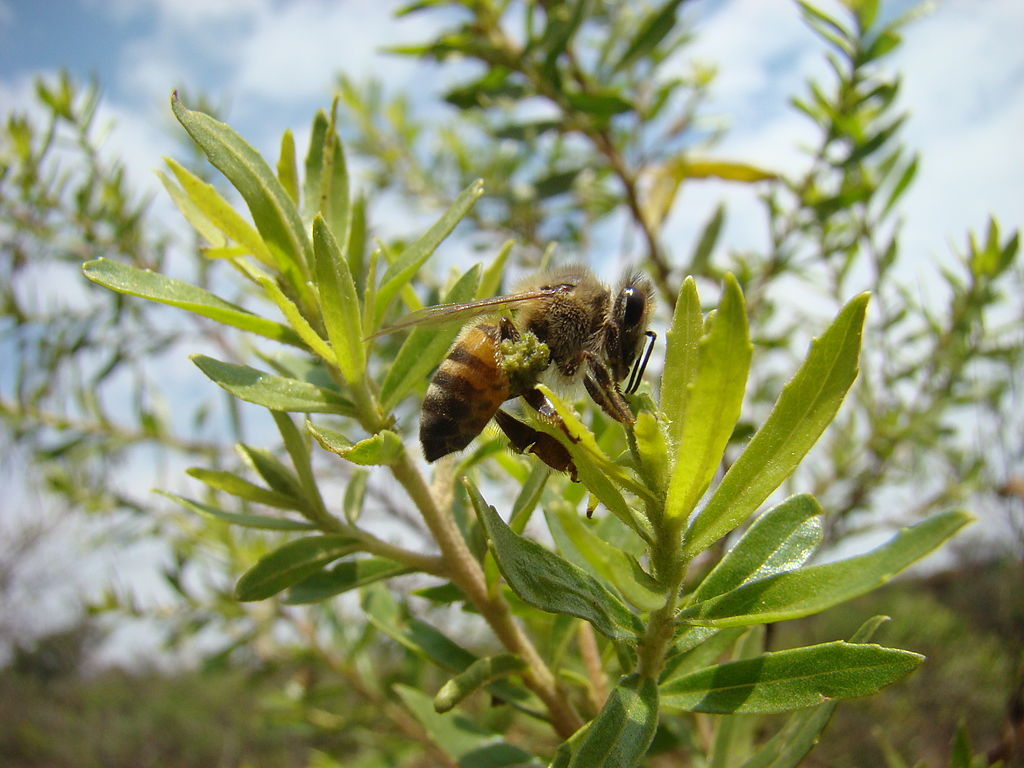

Artepillin C, the main component of green propolis, is a phenolic compound found in Baccharis dracunculifolia, a native Brazilian plant (photo: Michel Stórquio Belmiro/Wikimedia Commons)
The analysis compared the effects of artepillin C on healthy cells and cancer cells, as well as the effects on its efficacy of variations in the medium’s pH.
The analysis compared the effects of artepillin C on healthy cells and cancer cells, as well as the effects on its efficacy of variations in the medium’s pH.

Artepillin C, the main component of green propolis, is a phenolic compound found in Baccharis dracunculifolia, a native Brazilian plant (photo: Michel Stórquio Belmiro/Wikimedia Commons)
By Thais Szegö | Agência FAPESP – Propolis has long been used in traditional medicine and has won attention from the scientific community following proof of its health benefits, which include antioxidant, anti-inflammatory, antimicrobial, antitumor and immunomodulatory properties. Its composition varies according to origin, geographic location, and the bee species that produces it. Researchers affiliated with São Paulo State University (UNESP) in Brazil and the University of Southern Denmark (SDU) set out to analyze Brazilian green propolis, which is produced by the Africanized honeybee (Apis mellifera).
Its main component is artepillin C (3,5-diprenyl-4-hydroxycinnamic acid), a phenolic compound primarily found in the resin of Baccharis dracunculifolia, a native Brazilian plant (popular name alecrim-do-campo) known to have antitumor properties.
“Prior research showed that artepillin C can alter model biological membranes, thin films around living cells, especially when we vary the pH of the medium in which they are placed,” said Wallance Moreira Pazin, a professor in the Department of Physics and Meteorology at UNESP’s Bauru School of Sciences (FC).
The researchers decided to find out how healthy cells and tumor cells behaved biochemically when brought into contact with artepillin C, focusing for this purpose on fibroblasts – the primary cells in healing and maintenance of connective tissue – and glioblastoma cells respectively. Glioblastoma is the most common primary brain cancer.
The culture medium’s pH was also varied to see whether a more acid microenvironment would lead to different effects of artepillin C. “This is relevant because tumor tissue converts glucose into lactic acid and makes the extracellular microenvironment more acid,” said Pazin, first author of an article on the research published in the journal Life.
They next performed a meticulous analysis of the effects of the propolis on cell membranes, using an optical microscope to observe the integrity, fluidity and morphology of the membranes. The analysis showed that artepillin C interacted intensely with tumor cells, altering their fluidity and potential for reorganization. It also triggered autophagy, a cleansing process that involves degradation of worn, abnormal or malfunctioning cellular components.
The study was supported by FAPESP via four projects (16/09633-4, 17/23426-4, 18/22214-6 and 20/12129-1). According to Pazin, it contributes to a deeper understanding of the substance’s action mechanisms and provides insights for future research leading to innovative treatments for cancer.
“However, although in vitro trials have demonstrated high efficiency for this molecule’s biological activities, oral or topical administration to patients would be hindered by certain particularities, such as low absorption and bioavailability,” Pazin said. “In this context, strategies to enhance its therapeutic action will be required in order for progress to be possible in the use of artepillin C against tumors. An example would be the deployment of nanocarriers for controlled release.”
The article “pH-dependence cytotoxicity evaluation of artepillin C against tumor cells” is at: www.mdpi.com/2075-1729/13/11/2186.
Republish
The Agency FAPESP licenses news via Creative Commons (CC-BY-NC-ND) so that they can be republished free of charge and in a simple way by other digital or printed vehicles. Agência FAPESP must be credited as the source of the content being republished and the name of the reporter (if any) must be attributed. Using the HMTL button below allows compliance with these rules, detailed in Digital Republishing Policy FAPESP.





